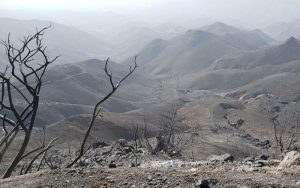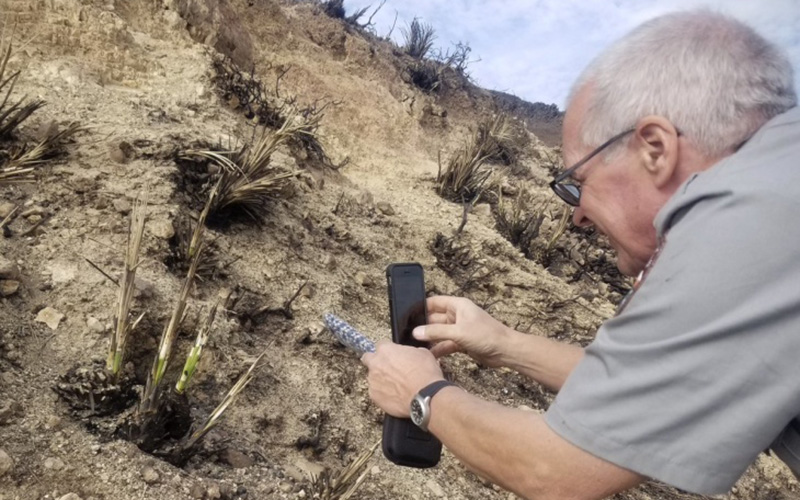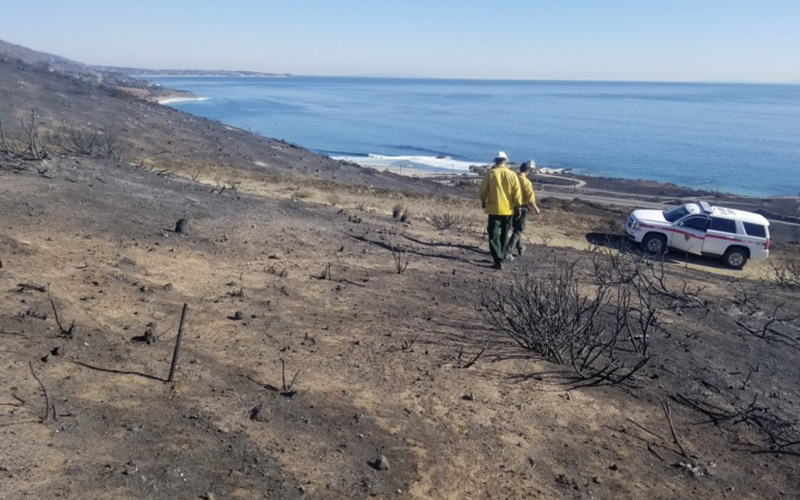
Time and timely rain are the most crucial factors in the initial recovery of the Santa Monica Mountains Recreation Area. Next year, the National Park Service hopes volunteers will sign up to plant new trees, maintain native plants and control invasive species. (Photo courtesy of National Park Service)
LOS ANGELES – Last month’s Woolsey Fire destroyed 88 percent of public land in the Santa Monica Mountains National Recreation Area, and experts with the National Park Service already are assessing the damaging and considering ways to restore the land.
NPS spokeswoman Kate Kuykendall previously described the park as a moonscape, and photos from the burn zone reveal the breathtaking scope to the devastation.
But although the Woolsey Fire was enormous, its overall intensity was not particularly severe, according to John Tiszler, a plant ecologist for the National Park Service who’s coordinating recovery efforts at the park.
“In the way that the shrubland burned, it wasn’t atypical,” he said, describing the burning as “low to medium intensity.”
That’s not to say the popular park, a mix of public and private land, didn’t suffer significant losses in the fire, which started Nov. 8 just south of Simi Valley, Cal Fire said. Three people died, 1,500 structures were destroyed and nearly 97,000 acres in Ventura and Los Angeles counties were consumed before it was fully contained Nov. 21. The cause has not been determined.
Tiszler, who has worked in the Santa Monica Mountains for 22 years, said the blaze destroyed many trees, especially oaks in woodland areas, leaving only blackened skeletons. For many trees, hollowed out by years of fires, this was the last straw.
They “just must have went up like a candle,” he said. “It’s just all gone.”

The Woolsey Fire blackened much of the Santa Monica Mountains National Recreation Area, which covers 153,785 acres. Of those, the National Park Service manages 23,648 acres. (Photo courtesy of National Park Service)
On the lookout for invasive plants
The National Park Service’s initial response is like triage, Tiszler said. One of the more immediate, critical tasks for rangers and scientists will be the “early detection and suppression of invasive plants,” he said.
Wildfires create opportunities for invasive species to muscle out native plants, Tiszler explained, which can have a lasting impact on the landscape and biodiversity in the mountains. Scientists already are seeing some of them sprouting from the scorched dirt.
NPS will also be replanting trees, but that work wouldn’t get going for several more months as researchers assess the area after California’s rainy season.
“By late spring, we should starts to get a sense of what’s coming back and what isn’t,” Tiszler said.
A lot of work will go into keeping the park’s many trails stable and safe so they can reopen to the public – and stay open. All that effort takes time, he noted.
“It’s a long-term commitment. It’s not something that we can turn around in a year.”
Time and the right rain needed
What it will take for the land to bounce back is a hard question with no quantifiable answer, but in a general sense, two things are needed: time and the right amount of rain.
We’ve been getting a fair amount of moisture these past couple weeks, but that can be a double-edged sword, Kuykendall said. Too much rain too close together could cause mud and debris flows, washing out seeds and new sprouts. But without enough rain, germinating seeds might not make it.
“If we kind of get the rains we’ve been seeing … that could be very beneficial in terms of encouraging regrowth,” Tiszler said, adding that one silver lining is the possible blooming of post-fire wildflowers, which “could be quite spectacular.”
He was quick to point out that the effort humans can put into recovery “is miniscule” compared to what nature will have to accomplish. And a major factor in how burned land will respond is its condition before a fire.
Recent dry years aren’t encouraging, but Tiszler said there’s no simple way to predict how well the Santa Monica Mountains will recover.
“Nature is really complex and we look for models to simplify it, but ultimately there can always be surprises,” he said.

Plant ecologist John Tiszler examines green shoots on a ravaged hillside in the Santa Monica Mountains of Southern California. (Photo courtesy of National Park Service)
Who pays for the restoration?
The initial money for recovery efforts comes out of the Burned Area Emergency Response, or BAER plan, which kicks in as soon as 14 days after the start of a fire. That money comes from the U.S. Department of the Interior’s emergency funds for fire suppression.
Tiszler said the key question officials will be asking is “what do we need to do to make our park land safe again?”
Based on that goal, a top priority is emergency trail and soil stabilization to prevent flooding, erosion and landslides. Tiszler said there will also be increased storm patrols to look for rock falls and other hazards throughout the park.
Money also will be used to replace equipment and infrastructure lost to the fire, including remote cameras used to study wildlife and protective fencing. More than a mile of split-rail fencing was destroyed in the fire, Tiszler said.
Another potential problem is that the fire has made more of the park accessible, so funds might also pay for extra law enforcement to patrol the park.
BAER funds are designed to last a year and are followed by up to four years of funds through the BAR program, or Burned Area Rehabilitation. That program aids efforts to grow new trees and plants and repair or replace NPS facilities.
BAR funds are determined by the executive branch and are competitive, Tiszler said. That means local park officials will have to make a case for getting them at a time when other national parks also have suffered devastating fires and are seeking aid. The Department of the Interior, which oversees the National Park Service, typically gets about $20 million to disperse among its land management bureaus, Tiszler said.
So, the service’s continuing role in helping the park recover will be determined by how much Interior receives from Congress, how much of that the department gives NPS and how much of that NPS allots to the Santa Monica Mountains National Recreation Area.
Tiszler said another source of funding could come through a special appropriations request to Congress, which would help the park repair and replace structures lost in the fire, which other funding won’t cover.
The park “lost a significant number of buildings,” Tiszler said, including a research facility, ranger housing and restrooms.
A collections building that housed much of the park’s significant archives also burned. Workers were able to save some items, but most of the paper materials, including historical photos, charts and maps, were destroyed.
“We lost a lot of the park history there,” Tiszler said.
Lessons from past fires
Tiszler has witnessed four major fires in the Santa Monica Mountains during his time with the park, most recently the Springs Fire, which burned roughly 12 percent of park land in May 2013.
“The Springs Fire was a bit of a disaster in terms of vegetation,” he said, describing a “huge diminishment of habitat value” in the years after the blaze.
Native shrubs were lost and replaced by annual grasses, which changes the “structural complexity” of the region, Tiszler explained. Wildlife, such as lizards and snakes, that lived among certain plants can’t always adapt to the new landscape, which reduces biodiversity in the mountain range.
“Overly frequent fires can cause that type of conversion,” he said. “It’s worrisome that if we stay in the drought pattern … it could have a huge impact on the recovery of the native plants.”

The Woolsey Fire destroyed about 97,000 acres in Ventura and Los Angeles counties, burning south all the way to the Pacific Ocean. (Photo courtesy of National Park Service)
Would ‘seed bombs’ help?
After the Woolsey Fire, some local nature lovers wondered on Facebook whether NPS officials planned to use “seed bombs” before a storm system came through the area. Some even urged locals near the burn zone to hike out and disperse some on their own.
NPS scientists say it’s great that people want to help, but seed bombs aren’t the way to do it. First off, many don’t include native plants, which means potentially invasive species could sprout. And even if they are labeled as being native, that doesn’t necessarily mean they grow in the park, Tiszler said.
Second, considering the vast amount of charred land, “seed bombs won’t make a big impact,” he said. “You’re not going to find enough seeds to put out there.”
Tiszler added that native chaparral and coastal sage scrub should have a “sufficient seed bank to provide for strong regrowth.”
How can the public help?
Step one, “don’t throw seed bombs,” Tiszler repeated.
Right now, there’s not much the public can do, but the National Park Service is putting out the call for future volunteers to help plant new trees, maintain local plant life and control invasive species.
You can fill out this online form and NPS officials will start reaching out in early 2019.
To help local wildlife affected by the fire, NPS officials recommend donating to nonprofit rescue organizations that rehabilitate injured animals.
This story is part of Elemental: Covering Sustainability, a multimedia collaboration between Cronkite News, Arizona PBS, KJZZ, KPCC, Rocky Mountain PBS and PBS SoCal.
Connect with us on Facebook.